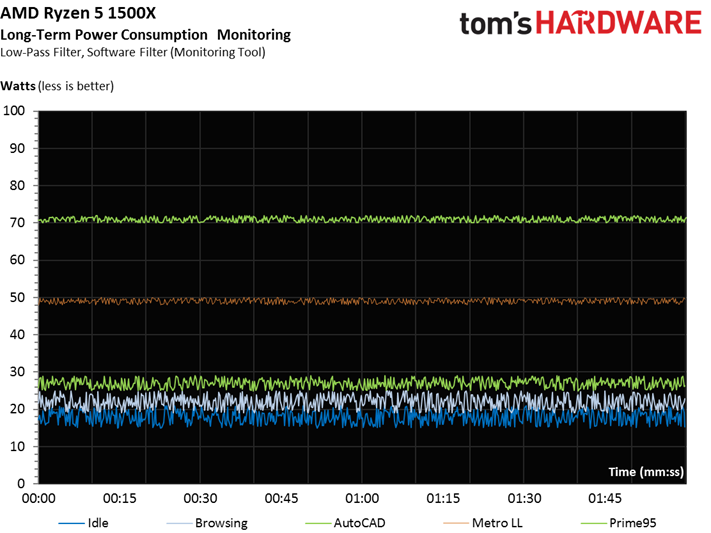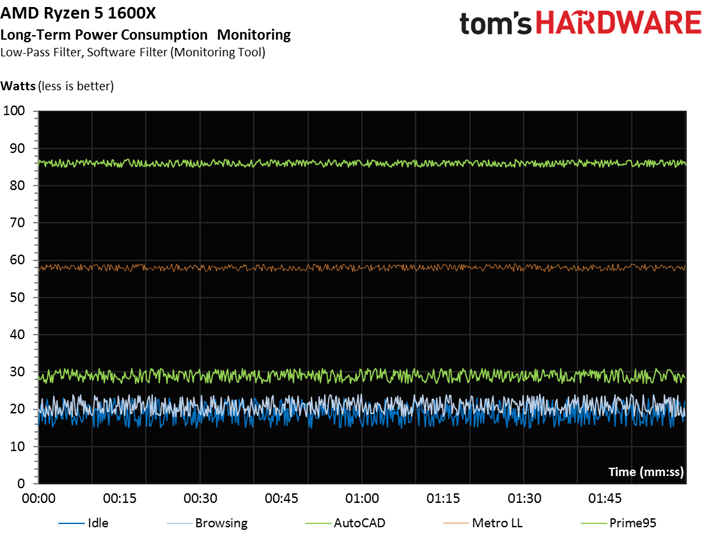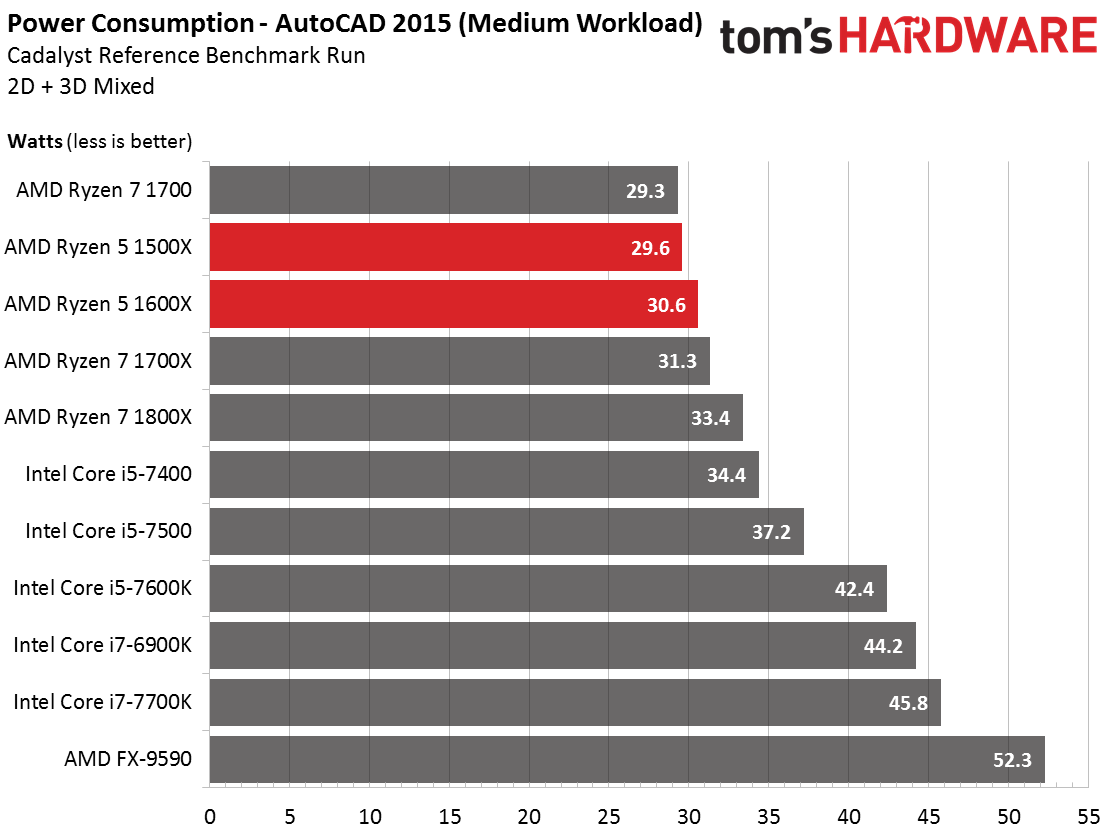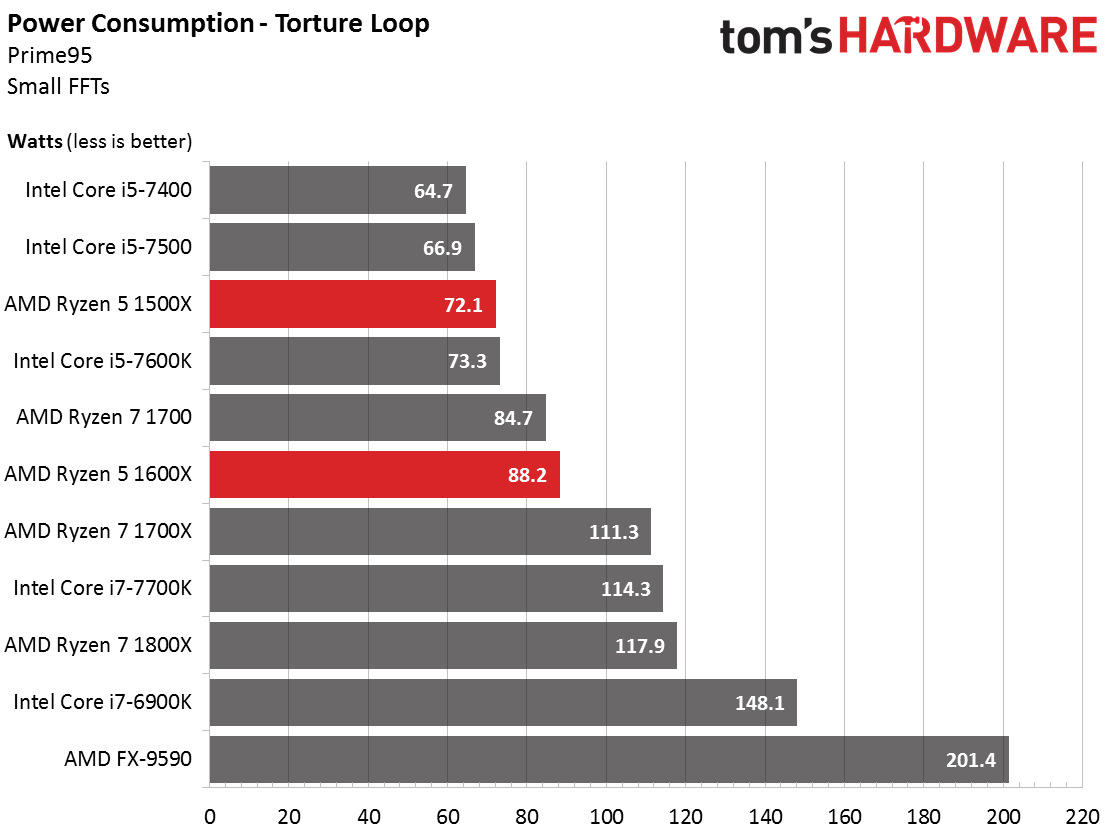AMD Ryzen 5 1500X CPU Review
Why you can trust Tom's Hardware
Temperature & Power Consumption
Temperatures
We calculated our temperature measurements on an adjusted scale, as we discovered some inconsistencies with AMD's temperature offset. Read more about this in our Ryzen 5 1600X coverage.
As expected, the Ryzen 5 1500X exhibits a slightly lower temperature range during the various tasks we look at, largely due to its four disabled cores and reduced frequency.
Power Consumption Comparison: Ryzen 5 Processors
Our power consumption results are based on numbers provided by the MSI motherboard’s sensors. We use a special low-pass filter for smoothing out brief peaks and valleys, along with an adjusted average calculation method.
We first take a look at the two new AMD Ryzen 5 processors on their own. The measurements and resulting curves are generated using long test intervals. These help circumvent (or at least minimize) bias errors caused by too little data.
A direct comparison between the AMD Ryzen 5 1500X and 1600X proves particularly interesting, since we're comparing quad- and hexa-core configurations based on the same die. Their idle, browsing, and AutoCAD results land very close to each other.
More demanding workloads change the picture a bit. Power consumption naturally rises on both CPUs, and by the time we hit our stress test, there's a large difference between the two models. The charts below illustrate what we mean even more clearly.
Power Consumption Comparison: All Processors
At idle, the differences between Ryzen CPUs are small. In fact, we can only measure them reliably with a 15-minute test run.
Get Tom's Hardware's best news and in-depth reviews, straight to your inbox.
There’s really no clear distinction between the quad-, hexa-, and octa-core models. The processors with deactivated cores don't appear to have those parts cut off electrically, so we assume they are still supplied with power.
Even though AutoCAD is only lightly threaded, the differences between AMD's Ryzen processors are marginal. More than likely, they're due to variation in chip quality and clock rate.
The higher-end Ryzen models consume more power during heavier loads. AMD’s Ryzen 7 1700 comes closest to hitting a sweet spot as a result of its lower clock rate. It takes the efficiency crown, though our benchmarks often show it to be slower than Ryzen 5s with fewer cores.
A similar picture emerges during the stress test. AMD’s Ryzen 7 1700, with its 16 threads and low frequency, uses less power than the six-core Ryzen 5 1600X. Meanwhile, the 4C/8T Ryzen 5 1500X fares significantly better than the other Ryzen models.
What we're finding in today's piece fits in well with findings from our Ryzen 7 reviews. That is to say the Ryzen 5 models aren't any more or less efficient than the higher-end Ryzen chips. We suspect that the Ryzen 5's chip quality isn’t any worse than Ryzen 7’s either, since efficiency isn't negatively affected and power consumption doesn't increase. Moreover, deactivating cores on the dual-CCX die doesn’t result in better efficiency, suggesting that those disabled parts are still supplied with power.
The power consumption results across AMD's Ryzen portfolio are solid compared to Intel's equivalent CPUs, except when it comes to our idle measurements.
MORE: Best CPUs
MORE: Intel & AMD Processor Hierarchy
MORE: All CPU Content
Current page: Temperature & Power Consumption
Prev Page Workstation Benchmarks Next Page Final Analysis
Paul Alcorn is the Editor-in-Chief for Tom's Hardware US. He also writes news and reviews on CPUs, storage, and enterprise hardware.
-
IceMyth I think you missed the i5-7600K from the Price per Usable Core/Thread table which is $57.2 if you buy it from OutletPC but if you buy it from Amazon.com it will be ~$60.Reply -
Shale Be careful, your fingerprint is visible on the CPU, someone could get enough of it from that photo to print and form a latex fingerprint that could be used to frame you for a crime, or depending on the finger and usage, be used for security breach or unlocking your phone.Reply -
InvalidError Cost per 1% low FPS might be a better metric: emphasize sustainability. Maybe a 35-45-20 blend of average-1%-0.1%.Reply -
Wisecracker <50w in the gaming loop is impressiveReply
Great job overall by AMD, and would love to see a 'head-to-head' with an OC'd AM3+ rig (FX-6350 at 4.5GHz?)
Page 5 _ "Civilization VI Graphics Test" Heading
-- graphic says, "Resident Evil 7"
-
jkhoward It has been shown time and time again that the AMD chip when paired with a Nvidia card has poor performance. You should really consider getting an AMD Workstation card for your test until Nvidia can fix the issue.Reply -
velocityg4 Why didn't you use the same CPU options for both the Workstation and gaming tests? It would have been helpful to know how an overclocked 1500x stands up against an i5-7500 in any use case. If someone is overclocking for gaming. They aren't likely to disable the overclock when working.Reply
It sounds like Toms German and US labs need to communicate a bit more to set exact testing requirements for a review. That way the reader receives consistent data.
As it stands now. The review is haphazard. There are different data sources for gaming, workstation, temperature and power. -
elbert Looks like the Ryzen 5 1500X bests the i5-7500 while overclocked. Should the test have included best OC with the stock cooler? Price is important at this level and an aftermarket cooler stripes it of the price advantage.Reply






